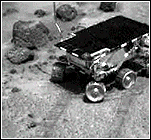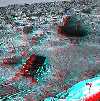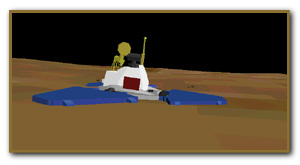
Seven days into surface activities on the Mars Pathfinder mission, all
spacecraft systems and instruments are continuing to perform well. The
rover remains in excellent health and appears to be driving a little bit
faster when left to its own devices than when it receives instructions
from Earth.
 |
"Basically the rover overshot its target rock, Yogi, by a little bit last night," explained Dr. Justin Maki, of the University of Arizona, who is a member of the Imager for Mars Pathfinder (IMP) team. Maki showed a movie of Sojourner as it approached the large boulder and began to climb up its side with one wheel. In this type of dead reckoning, the rover performed just as it should have, which was to back off the rock once it knew the rock was in the way, then turned and moved away from the object. Although the rover travels about 1 centimeter per second (about 2 feet per minute), it appeared to be moving a little bit faster on its own. |
The science team targeted the left side of Yogi for alpha proton X-ray spectrometer study because it appears to be dark and free of Martian dust. However, that side turned out to be tricky for the rover because of the rock's uneven contours and the slight depression in the soil beneath the rock. The rover team will instruct Sojourner to attempt instrument placement again tonight. Multiple attempts to position the science instrument were anticipated, making this repeat attempt nothing out of the usual.
 |
The "monster panorama" in stereo.(You'll need red/blue glasses for stereo viewing).It is broken into sections because of its large size. This frame is only a tile of a series covering 360 degrees. |
 |
Lander and Rover on Mars (748k)
Look at the lander and rover on a real estimate of the Mars Pathfinder landing site! |
The next scheduled press briefing will be held at 12:00 Noon Pacific Daylight Time on July 11 in JPL's von Karman Auditorium.
For more information, please visit our website at http://mpfwww.jpl.nasa.gov.